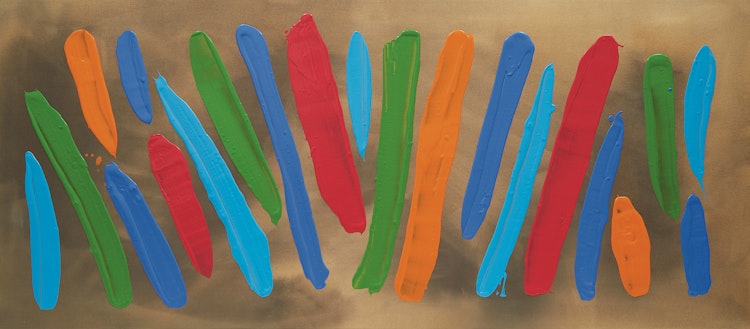AC-85-81 by William Perehudoff

William Perehudoff
AC-85-81
acrylic on canvas
signed, dated 1985 and inscribed “AC-85-81” on the reverse
35 x 78.25 ins ( 88.9 x 198.8 cms )
Auction Estimate: $20,000.00 - $30,000.00
Price Realized $33,040.00
Sale date: November 20th 2018
Waddington and Shiell Galleries, Toronto
Art Rental Service of the Art Gallery of Ontario
Private Collection, Toronto
Roald Nasgaard, Abstract Painting in Canada, Toronto, 2007, page 290
The Emma Lake Workshops of the early 1960s profoundly impacted Perehudoff’s work. During these workshops, he was introduced to Post-Painterly Abstraction by art critic Clement Greenberg and American artist Kenneth Noland. Many of the artist’s magnificent horizontal canvases of the 1970s and 1980s, such as “AC-85-81”, reference the reductive formalism of Color-Field painting as well as the expansive prairie landscape of his native province. Nasgaard notes how these works exhibit “plays of light and dark, of transparency and opacity, [which] are subtle and sensuous.” In 1988, Perehudoff was honoured to serve as a workshop leader at Emma Lake.
Perehudoff exhibited his work internationally, to significant acclaim, and in the late 1970s dedicated himself to his painting on a full-time basis. In the 1980s and 1990s, Perehudoff and his wife Dorothy Knowles spent more time in Langham, where they farmed and painted together.
Share this item with your friends
William Perehudoff
(1919 - 2013) RCA
William Perehudoff was born in Langham, Saskatchewan and maintained a connection to this area throughout his life. In 1944, the Saskatoon Art Centre opened, and this provided Perehudoff with early and important access to art. Within a couple of years he was exhibiting regularly in group exhibitions such as the Saskatoon Exhibition and the Art Centre fall show. Throughout this phase of his development as an artist, he farmed in the summer and devoted himself to painting and his art education in the winter. Like many artists of the time, Perehudoff had been influenced by the motivations and methodologies of social realist artists such as Diego Rivera. Perehudoff took instruction from the influential French muralist Jean Charlot, as well as Amédé Ozenfant in New York, the French Purist and associate of Le Corbusier. Kenneth Noland, a very important colour field painter, was also a major influence to his work. Since the 1960s, Perehudoff was a central figure in Canadian abstraction. The effect of the flat plains and open skies that are so dramatically present throughout Saskatchewan seem to be detectable in his work. William Perehudoff received the Saskatchewan Order of Merit in 1994 and an honorary doctorate from the University of Regina in 2003. He was named a Member of the Order of Canada in 1998.

